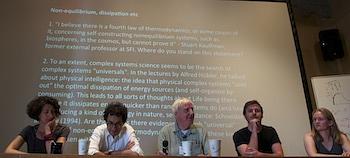
- 28 Jul 2015
By Connor O'Neil
Every summer, graduate students and postdocs congregate at the Santa Fe Institute’s Complex Systems Summer School (CSSS) for four weeks to learn, do research, and connect with like-minded peers. It is an exciting and fast-paced environment that transforms the atmosphere at SFI. Connor O’Neil of SFI’s Education and Outreach Program was in the thick of it and shared with Complexity Explorer a snippet of summer school life through his description below of a faculty panel discussion on complexity.
Every Friday morning of SFI's CSSS, about sixty-five students are bused from St. John’s College, along the Sangre De Cristo foothills, to the Santa Fe Institute. The Institute rapidly transforms from relaxed conversations over coffee to an electric community of already caffeinated academics preparing for the first lecture of the day. Staff or researchers who’ve forgotten that students are arriving are in for a shock, and a uniquely engaging rest of the day.
On the second Friday of the program, CSSS students were treated to an afternoon panel discussion featuring some of the faculty who are lecturing in the school. The students had already been exposed to half of the school’s content. Having heard varying definitions of “complexity” and unfamiliar jargon spanning every discipline, this was their opportunity to resolve some burning questions.
The panel—consisting of SFI Resident Faculty Mirta Galesic, External Faculty Simon DeDeo, Postdoctoral Fellow Laurent Hébert-Dufresne and Postdoctoral Fellow Christa Brelsford—navigated the students’ questions with the help of CSSS Director Sander Bais, who served as moderator. The audience went well beyond just the summer school students to include undergraduate researchers, SFI faculty, postdocs, staff, and members of the community who were somehow alerted to the event. All counted, the group certainly exceeded the capacity of SFI’s Robert Noyce Conference Room, and as individuals shuffled in throughout the discussion, floor space was restricted to standing room only. To everyone’s relief, afternoon storm breezes began pumping cool air through the patio doors as soon as the panel began.
It would take too much space to cover the entirety of questions addressed and topics discussed; however, there were a few stand-out questions that may give the reader a flavor of what attending the panel was like. The very first question was actually one of the most stimulating of the discussion:
“Interdisciplinary knowledge is valuable, but perhaps you need to be specialized to be useful to interdisciplinary work. Do you have thoughts on balancing these?”
Hébert-Dufresne responded with an analogy to an orchestra: adept specialists come together, and through reconciliation of their talents, produce the outcome they desire. Without refining one’s familiarity with a single topic, it may be difficult to contribute to interdisciplinary work as a whole. This sentiment was echoed by the others, including Galesic, who reminded the audience that “we cannot know everything.” Indeed, the panel generally agreed: one typically needs to become an expert on a specialized topic in order to contribute to interdisciplinary research.
This question of balancing specialization and interdisciplinary work was sufficiently interesting among the students to be raised a second time about a week later during a student-led discussion on patterns in education. At this discussion, Sander contributed the following thoughts on why specializing has its place:
“I think if we go deep enough, some of us will also find an urge to go horizontal. That is what happened to me. Maybe intense specialization provokes in us a desire to fill that sense of incompleteness. It is true that the math that is discovered at the level of deep specialization is rich, general and universal, so from that perspective, you are able to see where else your knowledge has value.”
Another somewhat lengthy discussion developed around the role of qualitative science: “If we don’t always have to quantify qualitative data, what other ways of approaching qualitative data can there be and for which problems in particular?”
Most of the panel agreed that qualitative questions are useful for distilling the pool of potential questions to those deserving of quantitative research. SFI postdoc Christa Brelsford suggested that in order to have a sense of what the good questions are—which are those worth asking—you often need to develop a qualitative description first. Sander Bais elaborated on this by proposing a continuum of explanation for each problem, one that varies between qualitative and quantitative descriptions.
The last of the questions I’ll highlight centered on limits of understanding:
“What evidence do we have that understanding complex systems is a task the human mind is capable of? What if we reached the point where it's fundamentally beyond our comprehension?”
The panel had clearly grappled with this issue before. SFI external professor Simon DeDeo responded,
“The notion that ‘we’ll never be able to solve X’ gets a lot of attention, but it is often not true.”
He continued by stating that the perceived limit of understanding imposed by “the hard question of consciousness” —the problem of explaining how we subjectively experience the world—has harmed science.
Sander made similar reference to "no-go" theorems in physics, which make an attempt to prove that a certain line of research is futile. Often times, the no-go theorem encourages even more exploration into the field to find out where the limits, if any, actually exist.
As a final comment on the notion of limits, SFI Omidyar Fellow Sam Scarpino took the stage from the far side of the conference room. Scarpino offered his optimistic appraisal of the work ahead, reassuring everyone that the doors are still open.
“Throughout your academic career, you will be told that some routes are closed. Just keep in mind that your advisors are often wrong. They came of age in a different scientific world, and you do not need to listen to them if it means giving up on an idea that really interests you.”
This seemed to be exactly what the crowd wanted to hear, and one could hardly ask for a better way to conclude the panel. The crowd diffused out of the conference room to the patio and atrium, where the only remnants of a storm were a colored sky and slightly cooler evening. Conversation ensued.
